Amritsar travel guide for first-time visitors & 10 Best Visit Places.
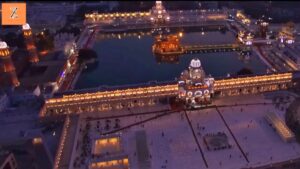
A trip to Amritsar is like striking travel gold. As the largest urban area in Punjab, Amritsar is one of India’s most deeply spiritual cities. Tens of thousands of devout Sikhs and cultural tourists alike make a pilgrimage to Amritsar every day for one main reason: a visit to the famous Golden Temple. There’s nothing quite like strolling around the glistening structure and sitting down for a communal meal from the Temple’s massive volunteer-run kitchen with dozens of other visitors. Beyond the Golden Temple, Amritsar offers an array of historical landmarks, serene gardens, and vibrant cultural experiences. Let’s explore the top 10 rated attractions and places to visit in Amritsar.
Best Time to Visit
Plan your trip between October and March to enjoy pleasant weather. Avoid peak summer months (May-June) as temperatures can exceed 40°C.
10. Gobindgarh Fort

- Timings: 10:00 AM to 10:00 PM (daily).
- Entry Fee: ₹180 for children, ₹285 for adults; separate charges for activities and shows
More than 250 years old, Gobindgarh Fort is one of the most iconic symbols of Punjab. This heritage site dates back to a time when the Indian subcontinent was divided into small principalities ruled by kings. At its peak, some 12,000 soldiers manned the fort to protect Amritsar from potential invaders. In modern times, Gobindgarh Fort has transformed into an educational attraction dedicated to Amritsar’s history and culture. The complex houses four museums, including a Warfare Museum showcasing rare weapons, a Turban Museum highlighting regional headgear, and a Sikh Art Museum. Stick around after dark for the captivating light and sound shows projected on the fort’s colonial bungalow.
9. Khalsa College

- Timings: Open to visitors during the day.
- Entry Fee: Free for campus visit (buildings are restricted to students/staff).
Architecture buffs should make a point to visit Khalsa College on Grand Trunk Road in Amritsar. This historic educational institution doubles as a premier example of 19th-century Indo-Saracenic architecture, blending Western European aesthetics with the exuberance of Indian and Persian styles. The elegant onion domes and scalloped archways of the college’s palatial main building are impressive and have served as the setting for many Bollywood films. Spend some time wandering the tranquil campus and gardens, but remember that the academic and administrative buildings are reserved exclusively for students and staff.
8. Rambagh Gardens and Maharaja Ranjit Singh Museum
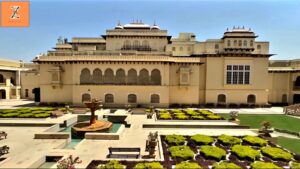
- Timings: Gardens: Open during daylight hours; Museum: 10:00 AM to 5:00 PM (closed Mondays).
- Entry Fee: Museum charges ₹10 for Indian visitors, ₹50 for foreigners.
Looking for a serene escape from the hectic streets of Amritsar? Head to Rambagh Gardens, a sprawling public park that brims with rare plants, flowers, and trees. The gardens feature refreshing water features filled with goldfish and statues, including a memorial for Maharaja Ranjit Singh, the leader of the Sikh Empire in the early 1800s. At the center of the park, you can explore the historic Summer Palace.
While less elaborate than other Indian palaces, this two-story red sandstone building boasts scalloped doorways, inlaid marble floors, and charming balconies. Don’t miss the Maharaja Ranjit Singh Museum and Panorama in the northwest corner of the gardens. This museum showcases artifacts of Sikh culture, including garments worn by warriors and antique coins, along with a multimedia diorama of Maharaja Ranjit Singh’s life and battles.
7. Baba Atal Tower

- Timings: 6:00 AM to 7:30 PM (daily).
- Entry Fee: Free.
Often overshadowed by the neighboring Golden Temple, Baba Atal Tower is a must-visit attraction in its own right. This nine-story octagonal tower rises 40 meters high, making it one of the tallest structures in Amritsar. Dedicated to Baba Atal Rai, the son of a Sikh Guru, the tower has an intriguing story. Legend has it that Baba Atal Rai performed a miracle to bring someone back to life and then sacrificed his own life in penance for interfering with divine will. The viewing platform at the top offers some of the best panoramic views in Amritsar.
6. Jallianwala Bagh
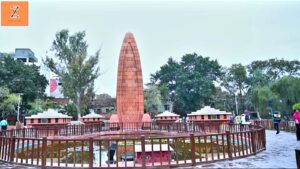
- Timings: 6:30 AM to 7:30 PM (daily).
- Entry Fee: Free.
Tucked behind the Golden Temple, Jallianwala Bagh is an important historical site in Amritsar. This public garden commemorates the estimated 1,500 people who were killed or injured in 1919 when British soldiers opened fire on peaceful protesters demanding the release of Indian independence leaders. You can still see bullet holes in the walls where victims sought shelter. The Martyrs’ Gallery showcases portraits of key figures in the independence movement, while a humbling exhibition honors the victims. Don’t miss the eternal flame, which serves as a poignant reminder of the lives lost during this tragic event.
5. Mata Lal Devi Mandir

- Timings: 6:00 AM to 9:00 PM (daily).
- Entry Fee: Free.
Mata Lal Devi Mandir is as whimsical as the Golden Temple is elegant. Dedicated to the female saint Mata Lal Devi, this Hindu temple is believed to boost fertility in women who visit. For non-devotees, the labyrinthine attraction resembles a funhouse. Visitors can navigate dark, narrow passages leading to vibrant rooms covered in mirrored mosaics, walk through the open mouths of animal carvings, and crawl through a watery cave to the shrine of Mata Lal Devi. The entire experience offers a unique perspective on Hinduism and is one of the most fun things to do in Amritsar.
4. Punjabi Restaurants

- Timings: Generally available between 12:00 PM – 2:00 PM or 6:00 PM – 8:00 PM, depending on the operator.
- Entry Fee: Free.
Punjab’s cuisine is renowned worldwide for its bold flavors, pillowy breads, and tandoori-fired meats. Amritsar is the perfect place to indulge in this culinary tradition. Visit Bharawan Da Dhaba near the Partition Museum for buttery Amritsari kulchas stuffed with Indian cheese or potatoes and served with spiced chickpeas. Try the Punjabi breakfast staple chole puri at Kanha Sweets, just a block away from BBK DAV College for Women. For mouthwatering tandoori chicken, head to the Beera Chicken House across from New Bhandari Hospital. If you have a sweet tooth, treat yourself to piping-hot jalebis at Gurdas Ram Jalebiwala, located just 400 meters from the Golden Temple.
3. Partition Museum
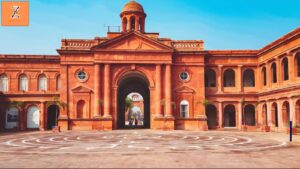
- Timings: 10:00 AM to 6:00 PM (Tuesday to Sunday; closed on Mondays).
- Entry Fee: ₹10 for children, ₹20 for adults, ₹150 for foreigners.
The year 1947 was monumental for India. It marked both the country’s independence from British rule and its partition into India and Pakistan. Tourists can learn about this defining moment in history at the Partition Museum, the only institution in the world dedicated entirely to the partition. The museum’s exhibits include newspaper clippings, antique photographs, and oral histories from people who experienced the violence and displacement of that era. Before leaving, write a message of hope on a green leaf and hang it on the museum’s “Tree of Hope.”
2. Wagah Border Ceremony

- Timings: Around 4:30 PM in summer and 5:30 PM in winter (arrive at least an hour early).
- Entry Fee: Free.
A 31-kilometer drive west of Amritsar’s city center will take you to the Wagah Border, where a fascinating border-closing ceremony occurs every evening at sunset. Known as the Beating Retreat Ceremony, this event features an elaborate display of goose-stepping guards from India’s Border Security Force and Pakistan’s Rangers. The guards salute each other, lower their flags, and close the border gates in a show of national pride. On the Indian side, the atmosphere is lively, with Bollywood music and patriotic dancing. The ceremony lasts just 45 minutes but leaves a lasting impression.
1. Golden Temple
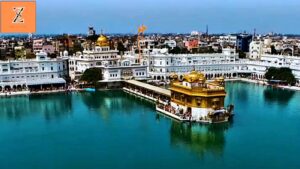
- Timings: Open 24 hours, every day.
- Entry Fee: Free.
The definitive top attraction in Amritsar is the Golden Temple, a two-story structure covered in real gold and surrounded by a 5.1-meter-deep man-made lake. This sacred shrine is one of the holiest places for Sikhs, many of whom make a pilgrimage here at least once in their lifetime. To enter the temple complex, visitors must cover their heads, remove their shoes, and step through a small stream of running water to cleanse their feet. Inside, you’ll walk along an inlaid marble path around the pool, listening to worshippers chant and bathe in the holy water. The inner sanctum houses priests who recite hymns from the Guru Granth Sahib, Sikhism’s holy text.
The Golden Temple is also home to the world’s largest community kitchen, which serves free vegetarian meals to up to 100,000 people daily. Visitors are welcome to volunteer in the kitchen, chopping vegetables and preparing meals alongside locals. For an immersive experience, consider staying at the temple’s pilgrim accommodations, which offer lodging for up to three nights. Seeing the temple bathed in the soft light of sunrise is a magical moment you won’t forget.
Read also: 25 Best Places to Celebrate New Year in India (2024)
Essential Travel Tips for Amritsar:
Cultural Etiquette: Respect local customs by dressing modestly, especially when visiting religious sites like the Golden Temple.Always cover your head with a scarf or cap while in the temple complex.
Footwear and Hygiene: Remove shoes and wash your feet before entering any gurudwara (Sikh temple). Carry wet wipes or sanitizer for convenience, especially after visiting crowded spots.
Golden Temple Tips: Visit early in the morning or late at night to avoid crowds and witness the serene atmosphere. Participate in the langar (community meal) for a unique experience.
Local Transport: Use auto-rickshaws or cycle-rickshaws for short distances. Hire a private cab or use ride-hailing apps for better convenience when visiting outlying areas like Wagah Border.
Food and Water Safety: Indulge in local delicacies, but stick to well-reviewed eateries to avoid stomach issues. Drink bottled or filtered water. Avoid tap water and ice in drinks unless you’re sure of its source.
Language: While Punjabi is the local language, most people understand and speak Hindi and English. Learning basic Punjabi phrases can be helpful.
Shopping: Visit local bazaars like Hall Bazaar for souvenirs, Phulkari embroidery, and Amritsari juttis (shoes). Bargaining is common, so don’t hesitate to negotiate.
Safety Tips: Amritsar is generally safe, but be cautious of pickpockets in crowded areas. Keep your belongings secure, especially in public transport and busy markets.

